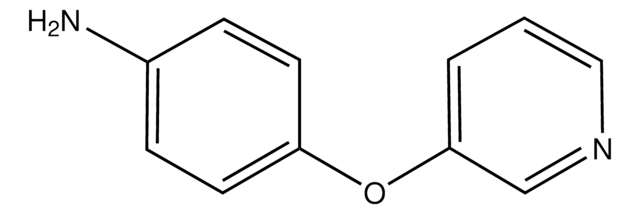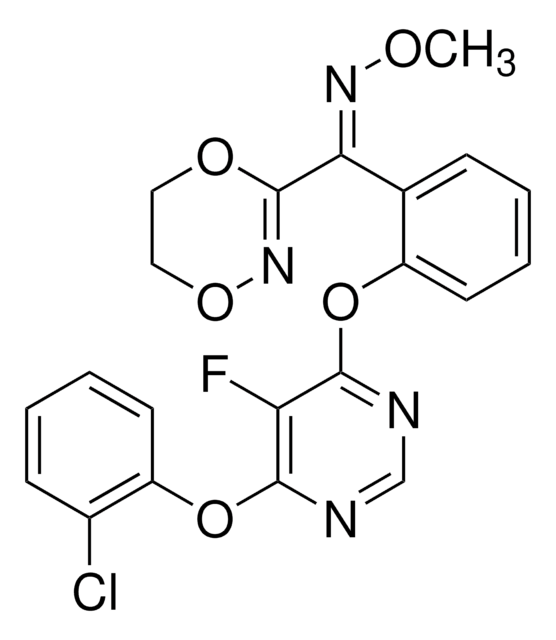CRM01345
氟吡菌酰胺
certified reference material, TraceCERT®, Manufactured by: Sigma-Aldrich Production GmbH, Switzerland
同義詞:
N-[2-[3-Chloro-5-(trifluoromethyl)-2-pyridinyl]ethyl]-2-(trifluoromethyl)benzamide, N-{2-[3-Chloro-5-(trifluoromethyl)-2-pyridyl]ethyl}-α,α,α-trifluoro-o-toluamide
登入查看組織和合約定價
全部照片(1)
About This Item
經驗公式(希爾表示法):
C16H11ClF6N2O
CAS號碼:
分子量::
396.71
Beilstein:
11323270
MDL號碼:
分類程式碼代碼:
41116107
NACRES:
NA.24
推薦產品
等級
certified reference material
TraceCERT®
品質等級
產品線
TraceCERT®
形狀
solid
儲存期限
limited shelf life, expiry date on the label
製造商/商標名
Manufactured by: Sigma-Aldrich Production GmbH, Switzerland
SMILES 字串
FC(F)(F)c1cnc(CCNC(=O)c2ccccc2C(F)(F)F)c(Cl)c1
InChI
1S/C16H11ClF6N2O/c17-12-7-9(15(18,19)20)8-25-13(12)5-6-24-14(26)10-3-1-2-4-11(10)16(21,22)23/h1-4,7-8H,5-6H2,(H,24,26)
InChI 密鑰
KVDJTXBXMWJJEF-UHFFFAOYSA-N
尋找類似的產品? 前往 產品比較指南
一般說明
This certified reference material (CRM) is produced and certified in accordance with ISO/IEC 17025 and ISO 17034. This CRM is traceable to primary material from an NMI, e.g. NIST or NMIJ.
Certified content by quantitative NMR incl. uncertainty and expiry date are given on the certificate.
Download your certificate at: http://www.sigma-aldrich.com
Fluopyram belongs to the class of succinate dehydrogenase inhibitor (SDHI) fungicides that are also used as a nematicide. It binds to complex II and blocks the mitochondrial electron transport chain, a fundamental component of the Krebs cycle. It is used to control grey mold, white mold (sclerotinia), and powdery mildew in crops such as table grapes, pome fruit, stone fruits, and vegetables, in addition to being used as a seed treatment for the control of nematodes. It is a broad-spectrum systemic fungicide that is absorbed by plant roots and leaves and distributed throughout the plant.
Fluopyram was approved on 1st February 2014 under the Commission Implementing Regulation (EU) No 802/20133 as per Regulation (EC) No 1107/20094 as revised by the Commission Implementing Regulations (EU) No 540/20115 and 541/201. Maximum residue levels (MRLs) for fluopyram have been set according to Reg (EU) 2021/1807 in various products of plant and animal origin from 0.01 to 60 mg/kg. Fluopyram has to be monitored in the Multiannual Control Programmes for Pesticides Residues (MACP), run within the EU and EFTA in/on products of plant origin.
Certified content by quantitative NMR incl. uncertainty and expiry date are given on the certificate.
Download your certificate at: http://www.sigma-aldrich.com
Fluopyram belongs to the class of succinate dehydrogenase inhibitor (SDHI) fungicides that are also used as a nematicide. It binds to complex II and blocks the mitochondrial electron transport chain, a fundamental component of the Krebs cycle. It is used to control grey mold, white mold (sclerotinia), and powdery mildew in crops such as table grapes, pome fruit, stone fruits, and vegetables, in addition to being used as a seed treatment for the control of nematodes. It is a broad-spectrum systemic fungicide that is absorbed by plant roots and leaves and distributed throughout the plant.
Fluopyram was approved on 1st February 2014 under the Commission Implementing Regulation (EU) No 802/20133 as per Regulation (EC) No 1107/20094 as revised by the Commission Implementing Regulations (EU) No 540/20115 and 541/201. Maximum residue levels (MRLs) for fluopyram have been set according to Reg (EU) 2021/1807 in various products of plant and animal origin from 0.01 to 60 mg/kg. Fluopyram has to be monitored in the Multiannual Control Programmes for Pesticides Residues (MACP), run within the EU and EFTA in/on products of plant origin.
應用
It is intended to be used as a certified reference material (CRM) for calibration in chromatography and other analytical techniques.
Fluopyram CRM may also find its use as described below:
Fluopyram CRM may also find its use as described below:
- Method development for analyzing the succinate-dehydrogenase-inhibitor fungicide residue levels in vegetable and fruit samples by liquid chromatography-tandem mass spectrometry
- Development and validation of monoclonal antibody-based immunoassays to analyze fluopyram residues in food samples
- Simultaneous estimation of fluopyram and tebuconazole in watermelon and soil samples using QuEChERS and GC-MS based method
- Determination of fluopyram, flupyradifurone, and indaziflam in date fruit, pistachio, and soil samples by ultra-high performance liquid chromatography with tandem mass spectrometry(UHPLC-MS)
- Develop and validate a method based on QuEChERS and UHPLC-Orbitrap-MS to determine fluopyram and its metabolites in cherry tomato and cucumber
法律資訊
TraceCERT is a registered trademark of Merck KGaA, Darmstadt, Germany
危險聲明
危險分類
Aquatic Chronic 2
儲存類別代碼
11 - Combustible Solids
水污染物質分類(WGK)
WGK 2
閃點(°F)
Not applicable
閃點(°C)
Not applicable
Analysis of Alternative New Pesticide (Fluopyram, Flupyradifurone, and Indaziflam) Residues in Pistachio, Date, and Soil by Liquid Chromatography Triple Quadrupole Tandem Mass Spectrometry
Mahdavi V, et al.
Soil & Sediment Contamination, 373-383 null
Antonio Abad-Fuentes et al.
Analytical and bioanalytical chemistry, 407(14), 4207-4211 (2015-03-23)
In recent years, a second generation of succinate-dehydrogenase-inhibitor (SDHI) fungicides has been introduced into the market for effective treatment of fruit and vegetable crops, with fluxapyroxad, boscalid, fluopyram, penflufen, bixafen, penthiopyrad, and isopyrazam being some of the members of this
Dissipation and residue determination of fluopyram and tebuconazole residues in watermelon and soil by GC-MS
Dong B and Hu J
International Journal of Environmental Analytical Chemistry, 493-505 null
Marta Vargas-Pérez et al.
Journal of the science of food and agriculture, 100(13), 4826-4833 (2020-06-06)
Fluopyram is a pesticide widely used in tomato and cucumber crops cultivation to control fungal diseases that develop especially in environments with moderate temperatures and high humidity, such as in a greenhouse. The pathway of fluopyram dissipation has been monitored
Eric Ceballos-Alcantarilla et al.
Food chemistry, 288, 117-126 (2019-03-25)
Monoclonal antibody-based techniques have become a useful analytical technology in the agro-food sector. Nowadays, residues of the recently registered fungicide fluopyram are increasingly being found in quality control programs. In the present study, novel chemical derivatives of this pesticide were
我們的科學家團隊在所有研究領域都有豐富的經驗,包括生命科學、材料科學、化學合成、色譜、分析等.
聯絡技術服務







